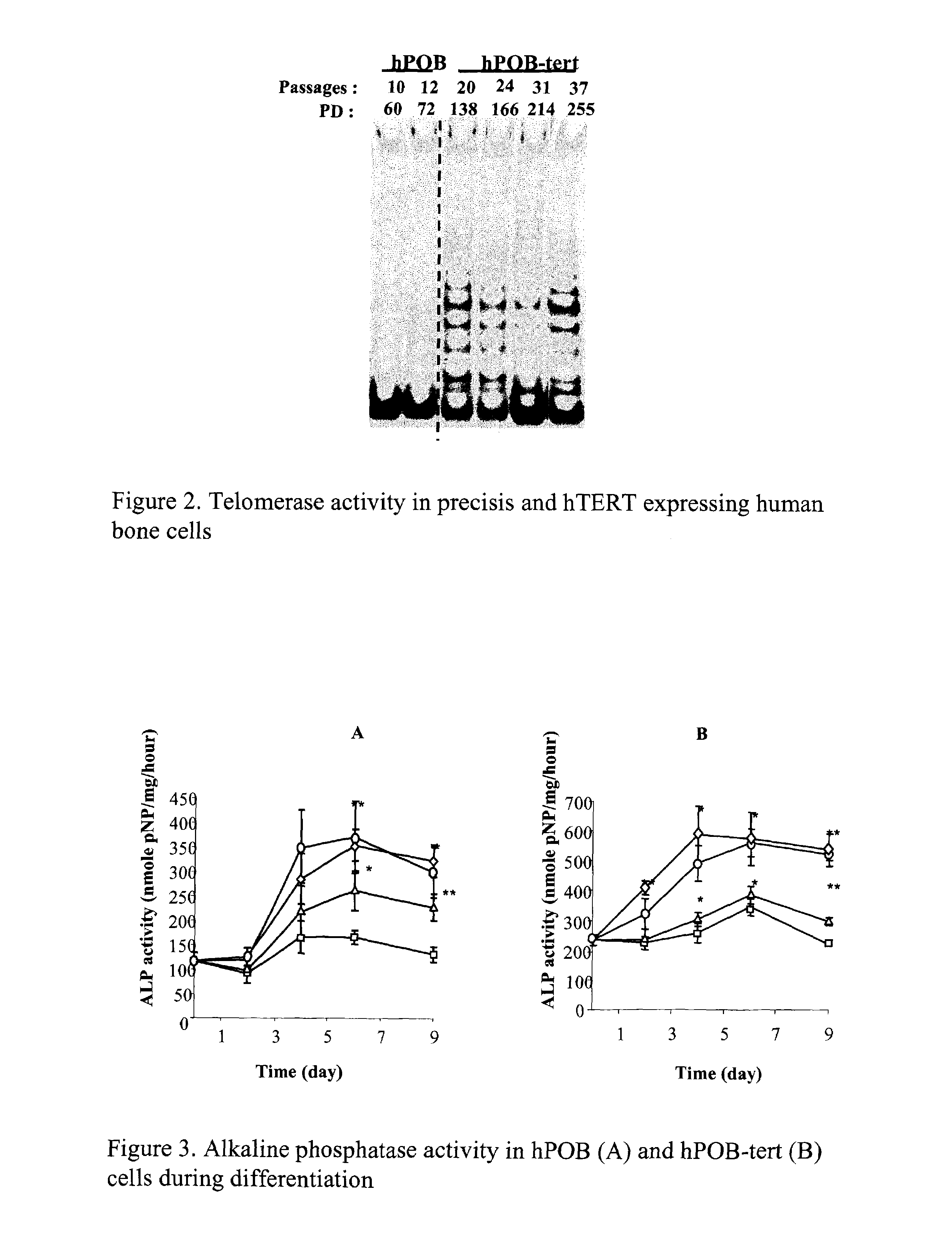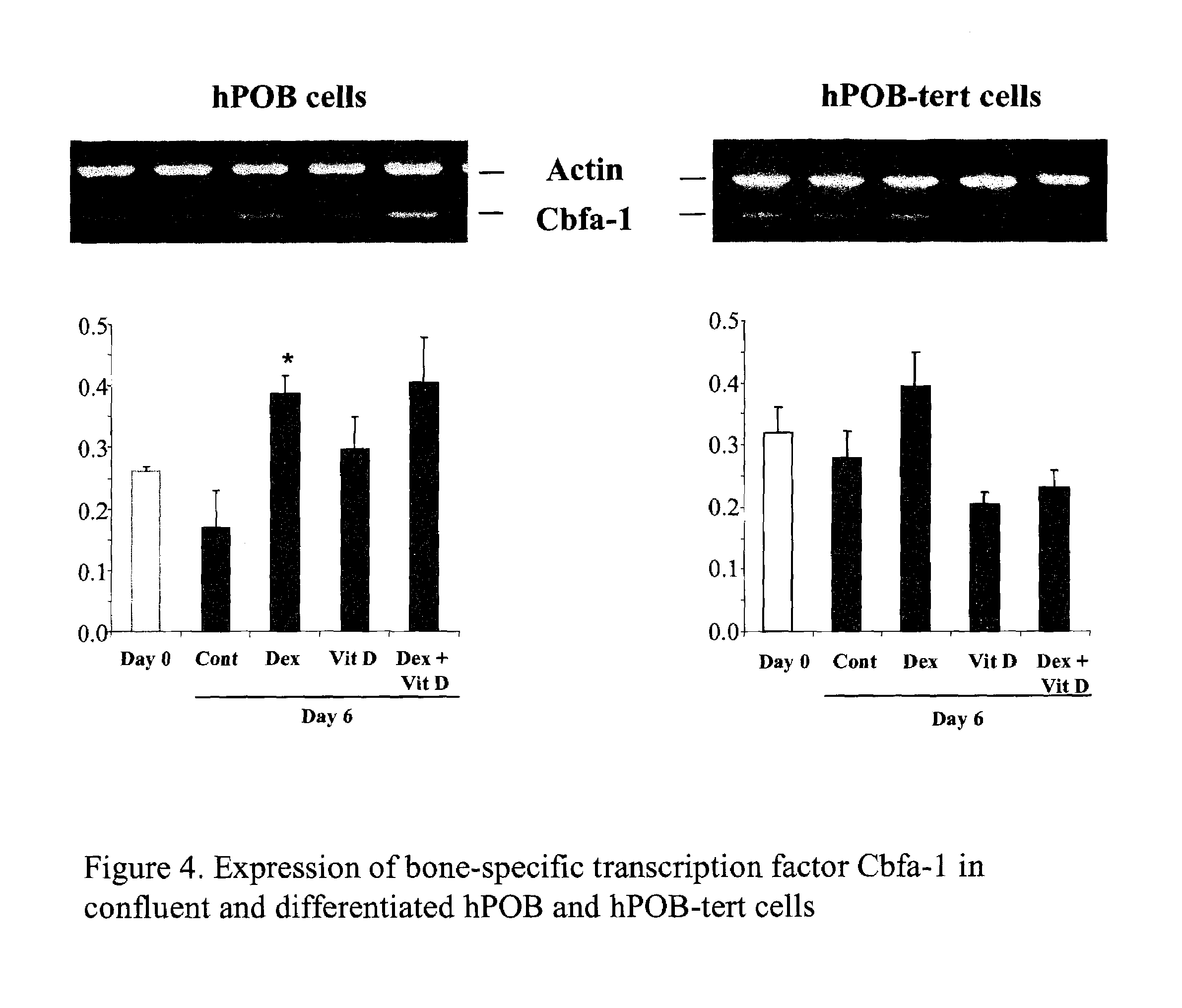Immortalized preosteoblasts and method for their production
a technology of preosteoblasts and cells, applied in the field of new immortalized preosteoblast cell lines, can solve the problems of lumbago fracture, preosteoblasts are, however, seemingly different, and the effect of activation of existing osteoblasts for the promotion and maintenance of bone mass is now rather doubted
- Summary
- Abstract
- Description
- Claims
- Application Information
AI Technical Summary
Benefits of technology
Problems solved by technology
Method used
Image
Examples
example 1
Preparation and Amplification of the Retroviral Vectors
[0040]A recombinant retroviral vector carrying the large T antigen gene of Simian Virus (SV40-T antigen) or the human telomerase reverse transcriptase (hTERT; provided by CAMBIA, Canberra, Australia) were constructed by insertion, with standard recombinant DNA techniques, into the BamHI site of the pLHXSD retroviral vector (Stockschlaeder et al., Hum Gene Ther. 2 (1991), 33–39) containing the histidinol gene as selection marker.
[0041]Infectious recombinant virus particles were generated through transfection of the recombinant retroviral vector into the amphotropic packaging cell line Phoenix (Clontech), followed by co-culturing with the ecotropic packaging cell line, Psi2, available in the ATCC, to allow “ping-pong” infection to produce a high-titer virus (Lynch C, Miller D. 1991). Production of high helper virus-free retroviral vectors was performed by cocultivation of packaging cells harboring envelopes of different host range...
example 2
Preparation and Infection of the Human Osteoblast Precursors
[0042]Cells from the periosteum of a femur of a 13 year old female patient were prepared by culturing pieces of preriosteal tissue in Opti-MEM (Gibco BRL; Basel; Switzerland) supplemented with 10% FBS in 95% air / 5% CO2 at 37° C. for 3 weeks. At confluency cells were trypsinised and plated in a 25 cm2 flask. At 70–80% confluency, cells were incubated for 3 hours at 37° C. (90% humidity) with the recombinant virus containing the SV40-T antigen, prepared as described in example 1, in the presence of 20 μg / ml DEAE dextran. After the infection, the culture medium was changed with α-MEM supplemented with 10% FBS and penicillin / streptavidin. After 3 to 4 passages non-infected primary cells stopped growing, while cells from the infected pool continued to proliferate until passage 12–15. These cells expressing the SV40 T antigen were named hPOB.
[0043]At passage 9, hPOB cells were infected, as described above, with a recombinant viru...
example 3
Culture and Differentiation of hPOBtert
[0044]Infected cells were cultured in the presence of α-MEM supplemented with 10% FCS and Penicillin / Streptavidin. This medium is referred as the basal medium. For differentiation, cells were seeded on collagen I (30 μg / ml; bovine skin-type I collagen; Roche Biomedical; Basel; Switzerland) coated dishes at a density of 12000 cells / cm2 in the basal medium. Confluent cells were incubated for 2 to 21 days in the basal medium supplemented with 1 mM β-glycerophosphate and 50 μg / ml ascorbate supplemented with 10 nM dexamethasone or 10 nM vitamin D3 (vitD).
[0045]The mineralized matrix formation was followed in infected cells cultured at day 0 and 21 after confluency under the differentiation conditions. After cell fixation by incubation with ice cold 70% ethanol for 1 hour, the mineralized matrix was stained with the Alzarin Red-S based calorimetric reaction.
PUM
| Property | Measurement | Unit |
|---|---|---|
| Mass | aaaaa | aaaaa |
Abstract
Description
Claims
Application Information
 Login to View More
Login to View More - R&D
- Intellectual Property
- Life Sciences
- Materials
- Tech Scout
- Unparalleled Data Quality
- Higher Quality Content
- 60% Fewer Hallucinations
Browse by: Latest US Patents, China's latest patents, Technical Efficacy Thesaurus, Application Domain, Technology Topic, Popular Technical Reports.
© 2025 PatSnap. All rights reserved.Legal|Privacy policy|Modern Slavery Act Transparency Statement|Sitemap|About US| Contact US: help@patsnap.com



